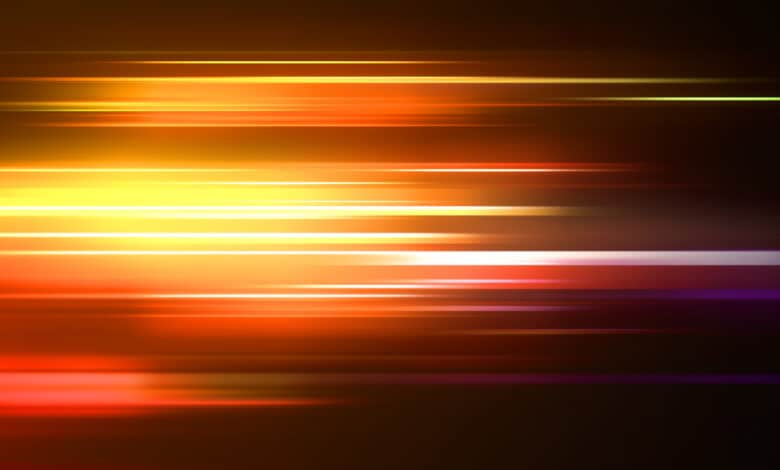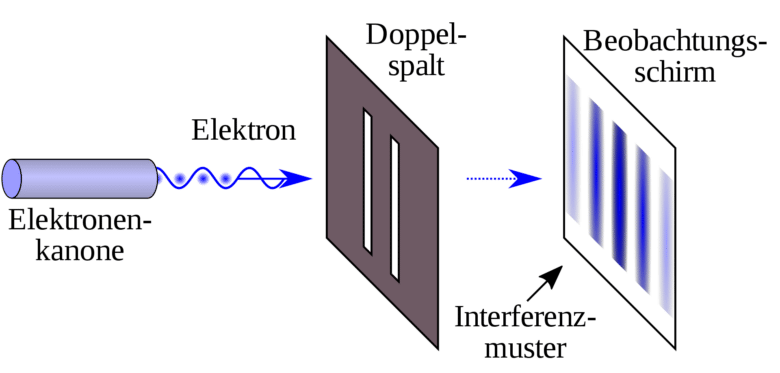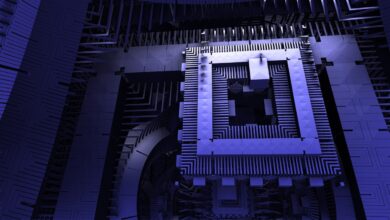
Researchers have succeeded in performing a new variant of the well-known double-slit experiment. Here, the slits through which the light is shot were realized not spatially but temporally.
The classical double-slit experiment
The double-slit experiment, which goes back to Thomas Young, is one of the most famous experiments in physics. It was used to show that light has wave properties and does not simply consist of particles, as Isaac Newton had assumed. Later, it was used to modify the wave hypothesis and thus served as the basis for quantum mechanics.
In the double-slit experiment, monochromatic light, i.e. light that has only one wavelength, is shot through a material that has two vertical slits. Behind this is a detector screen. The light, which has wave properties, splits due to the double slit. The light waves thus refracted interfere after the slit and produce a typical interference pattern on the detector screen. If the light consisted of particles in Newton’s sense, this interference phenomenon could not occur.

The double-slit experiment and quantum mechanics
Albert Einstein received the Nobel Prize in 1921 for explaining the photoelectric effect, which consists of photons interacting with matter in such a way that they can release electrons from their bonds. The photoelectric effect and its explanation are incompatible with the wave hypothesis of light, which seemed to be proven by the double-slit experiment: photons are light particles. Light is shed by a variation of the double-slit experiment, in which an attempt is made to shoot single photons through the double slit. Here, a result appears on the detector screen that seems like a mixture of the expected results for light waves and light particles. Initially, clearly definable individual points can be seen on the detector screen. If the experiment is carried out over a long period of time, however, an interference pattern appears on it, which is formed from these clearly delimitable points.
It becomes even more interesting when an attempt is made to determine the path of the photons. For this purpose, a device is attached to one of the two slits that polarizes the photons moving through it. In this way, the path taken by the photons can be clearly seen on the detector screen: Polarized ones have come through slit A, non-polarized ones through slit B. If this device is used, no interference patterns appear on the detector screen even after a long time. Instead, the result is an image that is only to be expected when light consists of particles, not waves. This effect is called the observation effect: If we start to measure in the described way, the behavior of the particles changes.
The results can be explained neither by Newton’s assumption that light consists of particles, nor by the assumption that light is composed of waves. Both assumptions, which seem to be mutually exclusive, can be both supported and weakened by the results. This in turn led to a paradigm shift that is the basis of quantum mechanics. Light exhibits both particle and wave properties. In some experiments, both show up, while in others, only one of the two properties shows up. Objects that exhibit such wave-particle duality are called quantum objects. What exactly constitutes these quantum objects and what wave-particle duality ultimately means is as yet unclear. It is precisely these questions that quantum mechanics is concerned with. Consequently, it would be inconceivable without the double-slit experiment that first demonstrated the existence of quantum objects.
Double-slit experiment with temporal slits
Researchers have now succeeded in performing another variant of the double-slit experiment. This one uses slits that differ in time rather than space. Specifically, a material was used that can be modified very quickly. With this material, two slits were created a few femtoseconds after each other. These were therefore not spatially adjacent, but temporally one after the other. The semiconductor material indium tin oxide was used for this purpose.
The result of the experiment is interesting. Unlike the spatial double-slit experiment, it was not the distribution of the radiation that was changed, but its frequency. The light is fanned out into different wavelengths by the slits opening one after the other in time. The new frequencies were up to ten bandwidths away from the original frequency. Since the frequency of the light determines its color, all this also means a color change of the light through the temporal double slit. The temporal distance between the two slits determines how wide the frequency spread is, while the shape of the slit determines the number of visible interference bands on the detector screen.
For the time being, these new research results are not relevant for practical applications. However, they could form the basis for the further development of optical quantum computers and data transmission based on them.



